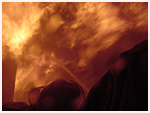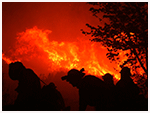« Arson Suspects Arrested | Home | Long Beach Fire Station 20 Profiled in the Press Telegram »
Northern California Brush Fire Deployment
By frhayes | July 23, 2008
Beginning in early June, Northern California had over 150 fires caused by lightning strikes and other means burning in numerous wild land areas. This situation caused a lack of Firefighters and equipment in which to extinguish these fires and protect threatened homes.
On a request from the Office of Emergency Services (OES) a Long Beach Fire Department (LBFD) Strike Team (Five Engine Companies and a Battalion Chief) was dispatched on July 10th, at 8:00 A.M. to travel the approximate 600 miles to Shasta County in Northern California to assist with firefighting operations. The strike team was assigned to the Motion and Iron Mountain Complex incidents throughout the eleven-day deployment, making this assignment one of the longest and furthest traveled deployments in the LBFD history.
During operations the strike team was primarily used for “Structure Protection” on houses that were built in heavily wooded areas. The multiple fires that had been started by lightning strikes and from “back firing” operations, served to form a large fire front that at numerous times threatened these homes.
On many of the days that fire crews operated temperatures reached over 110 degrees with virtually no wind, causing the smoke to congregate in low lying areas making it difficult to breath at times. The yellow nomex brush gear that was worn by firefighters for protection served to raise the bodies temperature causing concern for heat related illnesses such as; heat cramps, exhaustion, or stroke. Members took proactive measures to avoid these conditions by staying hydrated, seeking shade when possible, and rotating tasks that were strenuous in nature.
There were many lessons learned from this experience from all the members who were on this assignment, specifically how to manage and integrate into a large incident, and how this could be accomplished if required in the city of Long Beach. All of the Northern California Fire Department members and other individuals involved with fighting these fires were greatly appreciative of our participation in this campaign. During many of the early morning briefings before the strike team was assigned it was stressed that this was already one of the busiest fire seasons on record and that conditions were in place (hot weather and dry fuels) to make future requests for strike teams throughout all of California a real possibility. In fact historically speaking most of the Southern California brush fires start in mid to late Summer, and into early Fall.
Based on this information it is quit possible that the LBFD will be sending out strike teams to assist communities in both Northern and Southern California who become overwhelmed by brush fires that they are unable to handle on their own.
Deprecated: Function link_pages is deprecated since version 2.1.0! Use wp_link_pages() instead. in /home/firechan/public_html/blog/wp-includes/functions.php on line 6121
Topics: Incidents | 25 Comments »







